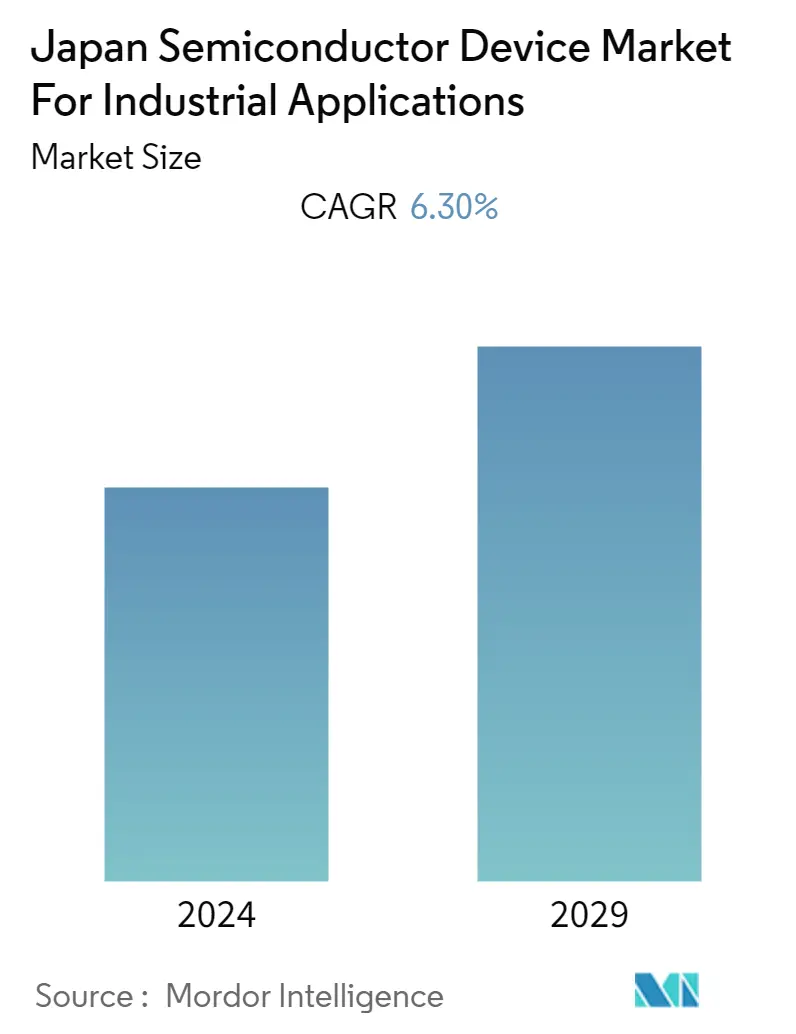Market Size of Japan Semiconductor Device Industry For Industrial Applications

| Study Period | 2019 - 2029 |
| Base Year For Estimation | 2023 |
| Forecast Data Period | 2024 - 2029 |
| Historical Data Period | 2019 - 2022 |
| CAGR | 6.30 % |
| Market Concentration | Medium |
Major Players*Disclaimer: Major Players sorted in no particular order |
Need a report that reflects how COVID-19 has impacted this market and its growth?
Japan Semiconductor Device Market Analysis
Japan Semiconductor Device Market For Industrial Applications is valued at USD 5.83 billion in the current year and is expected to grow at a CAGR of 6.3% during the forecast period to become 7.91 billion by the next five years. Owing to increasing applications for power, semiconductors are an uninterruptible power supply, typically used to protect hardware such as computers, data centers, telecommunication equipment, or other electrical equipment. An unexpected power disruption could cause injuries, fatalities, serious business disruption, or data loss. Uninterruptible power supply systems usually contain batteries and an inverter that uses IGBT.
The largest factor driving demand for semiconductor sales in Japan is the country's electronic products industry, one of the world's largest. According to the Japan Electronics and Information Technology Industries Association (JEITA), electronic device production in Japan in 2022 will be around JPY 11 trillion. The high demand for these products is one of the market's primary drivers.
Furthermore, the automotive industry accounts for a significant share of the total demand for semiconductors in the country. The automotive industry's migration from fossil fuel vehicles to hybrid and electric vehicles is driving strong demand for power devices. The leading power device makers drive to develop higher-performance devices on new materials such as SiC and GaN.
Increasing installations of robots create a positive outlook for the market. Japan is also the largest market for industrial robots. According to a recent report from the International Federation of Robotics (IFR), Japanese manufacturers account for 45% of the global supply of industrial robots, making them the top manufacturer of industrial robots compete. The country has also been rapidly increasing its production capacity. In 2022, recently increased 3.4% YoY to JPY 218.3 billion, marking the ninth consecutive quarter of YoY growth.
Moreover, Research and Development activities production continue to rise in the region, which will help foster product innovation. For instance, in July 2022, the United States and Japan world's production recently decided to launch a new joint international semiconductor research hub. They agreed to work on joint research for next-generation semiconductors.
Furthermore, the Japanese government approved a plan known as the 'Rebirth of Japan,' which outlines the route toward strengthening the manufacturing sector further by targeting the development of USD 1.3 trillion. By 2023, companies in the industrial sector are expected to accumulate revenues by as much as USD 490 billion in production due to Industry 4.0.
The outbreak of COVID-19 across the globe, including in Japan, significantly disrupted the supply chain and production of the studied market in the initial phase of 2020. For circuit and chipmakers, the impact was more severe. Due to labor shortages, many of Japan's package and testing plants reduced or even suspended operations. This also created a bottleneck for end-product companies that depend on semiconductors.
The Japanese government is taking stringent measures to revive its industries, such as consumer electronics and automotive. Also, the government wishes to reduce the clustering of production facilities in one place to reduce production dependency on geographical constraints. In line with this, Japan announced a USD 2.2 billion stimulus package to help its manufacturers to shift their production facilities out of China as COVID-19 disrupted the supply chain. The package specifies USD 2 billion for companies shifting back to Japan.
